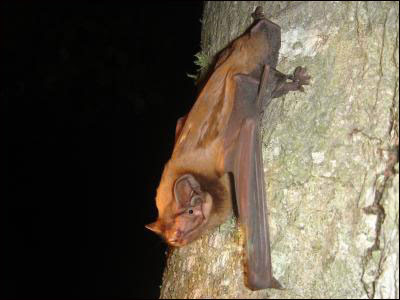 I heard this interesting story on NPR while driving into work this morning. Bat researchers in Spain have discovered that the giant noctule bat or Nyctalus lasiopterus preys on migrating songbirds who fly at night, something not previously known. It was previously thought that some songbirds migrated at night to avoid predation by diurnal raptors. Apparently it's not safe to fly at night either!
I heard this interesting story on NPR while driving into work this morning. Bat researchers in Spain have discovered that the giant noctule bat or Nyctalus lasiopterus preys on migrating songbirds who fly at night, something not previously known. It was previously thought that some songbirds migrated at night to avoid predation by diurnal raptors. Apparently it's not safe to fly at night either!From the article:
"Popa-Lisseanu is an expert on giant noctules, and says it has long been known that these bats feed on flying insects. What wasn't known until recently is that the giant noctule may be the only bat that eats birds on the wing. "
snip
"'They wrap the prey between their wings and the tail membrane,' Popa-Lisseanu says, 'so they make kind of a cage for the bird.' She says the bats eat just the 'most profitable parts' of the migrating bird, such as the breast, where birds accumulate fat and muscle.
When they get close to the ground, the bats open their wings and drop the mangled carcasses."
RTWT!
5 comments:
Interestingly, Darren at Tetrapod Zoology was onto an earlier version of this when I was first reading him.(Old site archives) I'll try to find a link-- or maybe he'll see and provide first!
I'm sure Steve would agree that were there but world enough and time, we would like to fly bats at night-migrating birds.....
Helen? Rebecca? Mark? Paul? Russ? You too? Of course.
Reid - heard the same story and posted on it as well - very cool stuff.
Steve - according to a different write-up: "In 2001, Carlos Ibáñez and his colleagues at the Doñana Biological Station in Seville, Spain, suggested that the giant noctule bat (Nyctalus lasiopterus), a rare European species occurring principally in the Mediterranean, may feed to a large extent on birds (Proceedings of the National Academy of Sciences 98, 9700-9702). They had found numerous feathers in the faeces of Spanish giant noctules, with occurrence peaks in the diet in spring and autumn, i.e. during main songbirds' seasonal migration. This contrasted strikingly with food composition of other European bat species which all feed exclusively on invertebrates!
This finding brought about a heated controversy among bat scientists. Some claimed that eating feathers was no proof of preying upon birds: they suggested that giant noctules could simply, and accidentally, ingest feathers hovering in the air, which are particularly numerous during migration events." I'll bet the original paper is what motivated Darren's older post - he knows all and tells all (don't know how he does it).
Matt - I'm already flying bats on migrating warblers - but since it happens at midnight and at high altitude, you'll have to take my word for it ;-).
Steve - found the Naish post here. Now I need to read up on hoary bats - the migration info you posted? Amazing!
Just think, Matt. You'd have to hunt with the bat hanging from your wrist rather than sitting on your glove. Probably want a good pair of night vision glasses, too!
Post a Comment